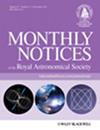The role of tidal interactions in the formation of slowly rotating early-type stars in young star clusters
IF 4.7
3区 物理与天体物理
Q1 ASTRONOMY & ASTROPHYSICS
引用次数: 0
Abstract
The split main sequences found in the colour–magnitude diagrams of star clusters younger than ∼600Myr are suggested to be caused by the dichotomy of stellar rotation rates of upper main-sequence stars. Tidal interactions have been suggested as a possible explanation of the dichotomy of the stellar rotation rates. This hypothesis proposes that the slow rotation rates of stars along the split main sequences are caused by tidal interactions in binaries. To test this scenario, we measured the variations in the radial velocities of slowly rotating stars along the split main sequence of the young Galactic cluster NGC 2422 (∼90Myr) using spectra obtained at multiple epochs with the Canada–France–Hawai’i Telescope. Our results show that most slowly rotating stars are not radial-velocity variables. Using the theory of dynamical tides, we find that the binary separations necessary to fully or partially synchronise our spectroscopic targets, on time-scales shorter than the cluster age, predict much larger radial velocity variations across multiple-epoch observations, or a much larger radial velocity dispersion at a single epoch, than the observed values. This indicates that tidal interactions are not the dominant mechanism to form slowly rotating stars along the split main sequences. As the observations of the rotation velocity distribution among B- and A-type stars in binaries of larger separations hint at a much stronger effect of braking with age, we discuss the consequences of relaxing the constraints of the dynamical tides theory.潮汐相互作用在年轻星团中缓慢旋转的早期型恒星形成中的作用
在年龄小于~ 600Myr的星团的色星等图中发现的分裂主序列被认为是由上层主序星的恒星旋转速率的二分法引起的。潮汐的相互作用被认为是恒星旋转速率二分法的一种可能的解释。这个假说提出,恒星沿分裂主序列的缓慢旋转速率是由双星中的潮汐相互作用引起的。为了验证这一假设,我们利用加拿大-法国-夏威夷望远镜在多个时期获得的光谱,测量了沿年轻星系团NGC 2422 (~ 90Myr)分裂主序列缓慢旋转的恒星径向速度的变化。我们的结果表明,大多数旋转缓慢的恒星不是径向速度变量。利用动力潮汐理论,我们发现,在比星团年龄更短的时间尺度上,二元分离对于完全或部分同步我们的光谱目标是必要的,在多历元观测中预测更大的径向速度变化,或者在单个历元预测更大的径向速度色散,比观测值大得多。这表明潮汐相互作用并不是沿分裂主序形成缓慢旋转恒星的主要机制。由于对大距离双星中B型和a型恒星的旋转速度分布的观测表明,随着年龄的增长,制动的影响要大得多,因此我们讨论了放宽动态潮汐理论约束的后果。
本文章由计算机程序翻译,如有差异,请以英文原文为准。
求助全文
约1分钟内获得全文
求助全文
来源期刊

Monthly Notices of the Royal Astronomical Society
ASTRONOMY & ASTROPHYSICS-
CiteScore
9.10
自引率
37.50%
发文量
3198
审稿时长
3 months
期刊介绍:
Monthly Notices of the Royal Astronomical Society is one of the world''s leading primary research journals in astronomy and astrophysics, as well as one of the longest established. It publishes the results of original research in positional and dynamical astronomy, astrophysics, radio astronomy, cosmology, space research and the design of astronomical instruments.
 求助内容:
求助内容: 应助结果提醒方式:
应助结果提醒方式:


